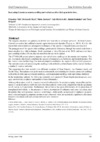Identificador persistente para citar o vincular este elemento:
https://accedacris.ulpgc.es/jspui/handle/10553/114181
| Título: | Increasing Cymodocea nodosa seedling survival at sea after their genesis in vitro. | Autores/as: | Vila, Francisco Tuya Cortés, Fernando José Zarranz, Maite Rieiro Leite, Luis Robaina Romero, Rafael Juan Bergasa Perdomo, Oscar |
Clasificación UNESCO: | 2510 Oceanografía 251001 Oceanografía biológica 241705 Biología marina |
Fecha de publicación: | 2014 | Conferencia: | IV Congress of Marine Sciences | Resumen: | The seagrass meadows are globally in decline due basically to anthropic pressure. In Gran Canaria, Cymodocea nodosa has suffered a severe regression in recent decades (Tuya et al. 2014). It is for this reason that conservation and propagation techniques of the species to degraded areas are required. The propagation of the specie with seedlings germinated in laboratory through harvested seeds from a donor meadow is a valid technique. Seeds germinate in vitro (Zarranz et al. 2010) and once they have got a seedling of about 10 cm, they are moved to the sea for its spread. The CYMOLAB project aims to improve survival of these seedlings in the marine environment. The two bottlenecks that largely condition the success of transplants are herbivory and hydrodynamics. For this reason a new methodology has been developed to minimize the negative effect of both processes. The method consists of surrounding the seedlings with artificial synthetic beams (raffia plastic) that have a similar C. nodosa leaf color. This experience has been tested it two different locations of Gran Canaria: Las Canteras beach and Gando’s Bay. Transplants were performed experimentally manipulating two factors: protected seedlings with artificial raffia and unprotected seedlings, and transplanted seedlings with and without fertilizer. In the monitoring realized, the following biometric were analyzed: Beam length (maximum and average), survival rate, epiphytes and number of bites (bitemarks). Although the project is still in progress, the results obtained so far are encouraging: an excellent performance of artificial raffia to herbivory (very few bite marks) is observed in comparison with the specimens which had no such protection. Furthermore, the technique has great effectiveness in the protection of transplanted individuals, in the presence of storms, in retention of sediments and speed reduction, once the patches that were protected survived much longer. Additionally an increased of epiphytes on specimens protected regarding unprotected ones wasn´t observed. Also, no statistically significant differences between individuals with and without fertilizer were observed. | URI: | https://accedacris.ulpgc.es/handle/10553/114181 | ISBN: | 84-697-0471-0 | Fuente: | Book of Abstracts submitted to the IV Congress of Marine Sciences. Las Palmas de Gran Canaria, June 11th to 13th 2014, p. 241 |
| Colección: | Actas de congresos |
Los elementos en ULPGC accedaCRIS están protegidos por derechos de autor con todos los derechos reservados, a menos que se indique lo contrario.
